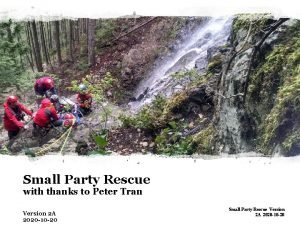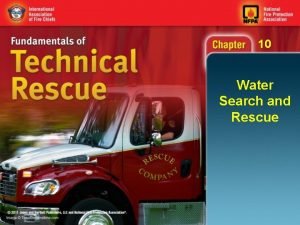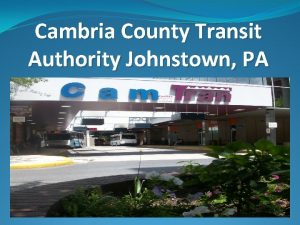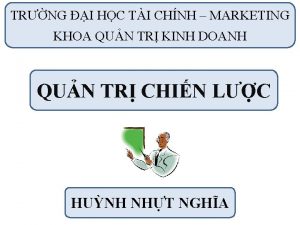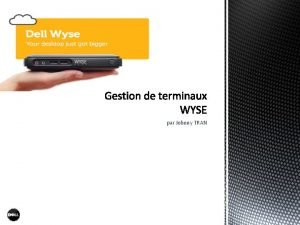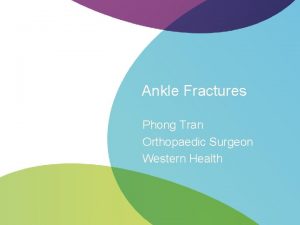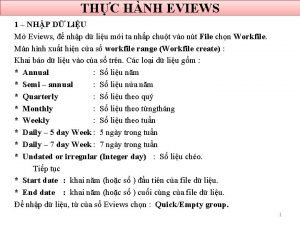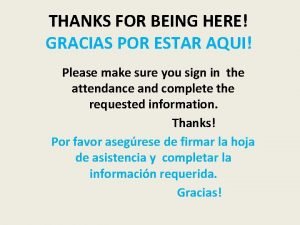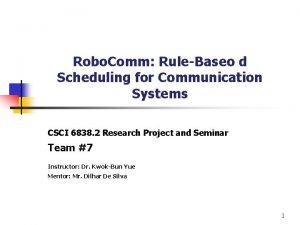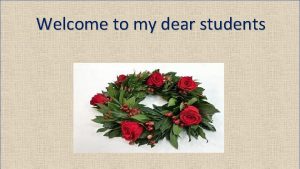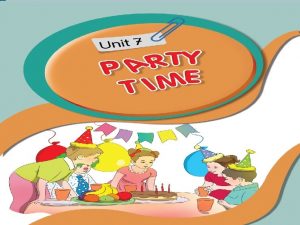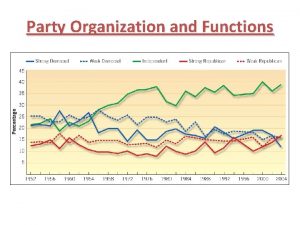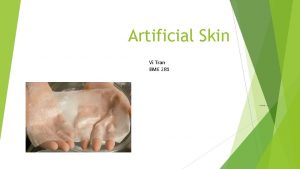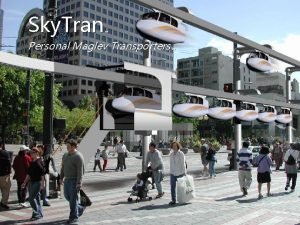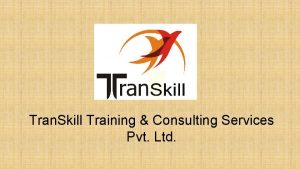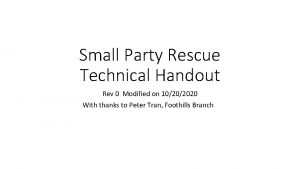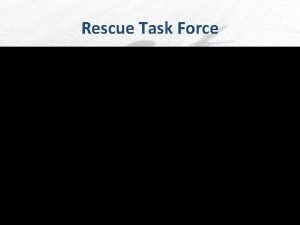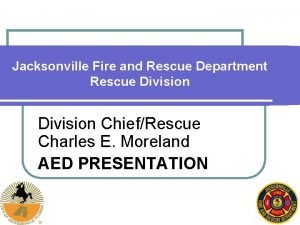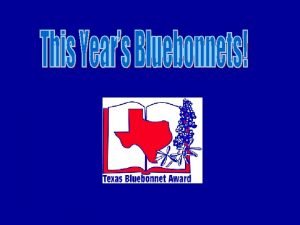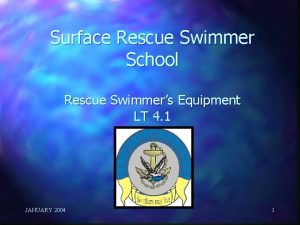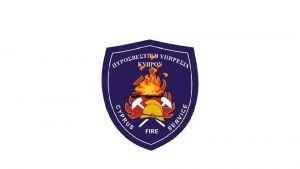Small Party Rescue with thanks to Peter Tran





































































- Slides: 69

Small Party Rescue with thanks to Peter Tran Version 2 A 2020 -10 -20 Small Party Rescue Version 2 A 2020 -10 -20

Handouts q Lecture Slides (this slide deck) q Technical Handout Small Party Rescue Version 2 A 2020 -10 -20

Outline èIntroduction q Tools of Alpine Rescue q Roles in the Rescue System q Running the Rescue q Teamwork, Leadership & Followership q Calling for Help Small Party Rescue Version 2 A 2020 -10 -20

Definitions èHigh angle – Terrain ~>60° èSteep Angle – Terrain ~> 35° ~ 60° èSubject – Injured person (not a patient) èPersonal Load – 1 person on a rope (1 k. N) èRescue Load – 2 people on a rope (2 k. N) èSafety Margin – Difference between your load and what your gear is rated for Small Party Rescue Version 2 A 2020 -10 -20

Goals of Small Party Rescue q Develop teamwork, leadership and followership. q Learn the tools of alpine rescue. q Develop the skill and confidence to creatively solve the problems needed to affect a rescue in steep alpine terrain. q Note: this is geared towards a “single pitch” alpine rescue scenario, but it can be used for multipitch rescue. The focus is to get everyone to a safe location to await further help, and not to get back to the cars Small Party Rescue Version 2 A 2020 -10 -20

Rule #1 of Rescue Do NO MORE DAMAGE to: Yourself Your teammates Your subject Small Party Rescue Version 2 A 2020 -10 -20

The Seven Steps to Accident Response 1. Take Charge! 2. Scene Size Up 3. Perform Emergency Rescue and Urgent First Aid 4. Protect the Subject 5. Assess the Subject (and Situation) 6. Make a Plan 7. Execute the Plan Small Party Rescue Version 2 A 2020 -10 -20

Rescue System Overview Main Belay Attendant Small Party Rescue Version 2 A 2020 -10 -20

Rescue System Safety Tests q Component Analysis? Do all of the rescue system components do what we intend them to do? q Critical Point Examination? Are all components backed up by other system components so that failure of any one point (gear or personnel) would cause a serious accident? q Whistle Test? If a whistle sounded and every rescuer let go of the system, would the system still protect the rescuers and subject from catastrophe? Small Party Rescue Version 2 A 2020 -10 -20

Outline q Introduction èTools of Alpine Rescue q Roles in the Rescue System q Running the Rescue q Teamwork, Leadership & Followership q Calling for Help Small Party Rescue Version 2 A 2020 -10 -20

Tools of Alpine Rescue q Anchors q Belay Systems q Load Release Hitches q Lowering Systems q Raising Systems q High Directional q Attendant-Subject Tie-in q Static vs. Dynamic Ropes q Material Strengths Small Party Rescue Version 2 A 2020 -10 -20

Anchors q Natural Protection Trees, Rock Features Wrap-3 -Pull-2 or Wrap-2 -Pull-1 Basket Hitch q Artificial Protection Bolts, Cams, Nuts, Hexes, pitons, etc. Ice Screws, Pickets, V-threads q Single vs. Multi-point S-E-R-E-NE Solid (bombproof) most important! Small Party Rescue Version 2 A 2020 -10 -20

Wrap-3 -Pull-2 Anchor Small Party Rescue Version 2 A 2020 -10 -20

Masterpoint Anchor Small Party Rescue Version 2 A 2020 -10 -20

Basket Hitch Small Party Rescue Version 2 A 2020 -10 -20

Munter Hitch Belay Photo: Dave Shema Small Party Rescue Version 2 A 2020 -10 -20

Load Release Hitches q Munter-Mule Climbing Rope or Cord Best for belay tie-off and belay escape q Munter-Mariner’s Hitch Cord - can be pre-tied or tied when needed Best for rescue load tension transfers q Mariner’s Hitch Cord or Webbing Best if tied when needed and pre-tensioned Small Party Rescue Version 2 A 2020 -10 -20

Load Release Hitches q When to use a load release hitch? ** A L W A YS ** o Anytime a rope (or friction hitch) is loaded, a “device” which allows the load to be released or transferred MUST be used. o Use for belay escape, knot passes and raise-to- lower system changeovers. Small Party Rescue Version 2 A 2020 -10 -20

Munter-Mule Small Party Rescue Version 2 A 2020 -10 -20

Munter-Mariner’s Hitch Small Party Rescue Version 2 A 2020 -10 -20

Munter-Mariner’s Hitch In Use Small Party Rescue Version 2 A 2020 -10 -20

Mariner’s Hitch Small Party Rescue Version 2 A 2020 -10 -20

Belay Escape – Other Options Cordelette Mariner’s Hitch Kleimheist Small Party Rescue Version 2 A 2020 -10 -20

Belay Escape to Rescue System Nothing, Leave “As Is” Lowering System Raising System Belay System Small Party Rescue Version 2 A 2020 -10 -20

Belay Escape to Rescue System 3: 1 Z-Pulley Munter-Mule Small Party Rescue Version 2 A 2020 -10 -20

Double Munter Hitch Small Party Rescue Version 2 A 2020 -10 -20

ATC Brake Small Party Rescue Version 2 A 2020 -10 -20

Tandem Rappel Small Party Rescue Version 2 A 2020 -10 -20

3: 1 “Z-Pulley” Raising System Small Party Rescue Version 2 A 2020 -10 -20

5: 1 Raising System Small Party Rescue Version 2 A 2020 -10 -20

High Directional ? Small Party Rescue Version 2 A 2020 -10 -20

Attendant-Subject Tie-in o Small Party System Rescuer connected to BOTH ropes Subject connected to BOTH ropes o How to achieve Attendant: Longtail bowline to main line, prussik to belay line Subject: Figure 8 from bowline to main line, prussik to main line, figure 8 to belay line Small Party Rescue Version 2 A 2020 -10 -20

Longtail Bowline subject Small Party Rescue Version 2 A 2020 -10 -20

Attendant & Subject Tie-in Long Tail Bowline Prusik on Main To Subject “Main Line” Figure 8 from “Main Line” Prusik on Belay to Attendant Fallen Climber/”Belay Line” Small Party Rescue Version 2 A 2020 -10 -20

Carabiner Block-and-Tackle A simple pulley system. A method of extracting a subject from loaded accident rope. Raise subject just enough to release the tension on their tiein knot. An efficient “wall pick-off. ” Doesn’t work well for everyone. Small Party Rescue Version 2 A 2020 -10 -20

Carabiner Block-and-Tackle Carabiner block-and-tackle tied off with a Mule knot and Overhand back-up. Small Party Rescue Version 2 A 2020 -10 -20

Static vs. Dynamic Rope q Dynamic Rope Climbing rope 8 -10% elongation (static), up to 30% dynamic 60 m of rope � 6 m fall if main line fails! Keep lowers and raises short! q Low-stretch “Static” Rope Rescue rope, Haul line 1 -2% elongation 100 m rope � 2 m fall if main line fails Small Party Rescue Version 2 A 2020 -10 -20

Material Strengths Rescue Load (2 people and gear) ~ 2 k. N q 9 mm Dynamic Rope ~ 20 k. N q 10. 5 mm Dynamic Rope ~ 28 k. N q q 1 -inch Webbing ~ 20 k. N q 9/16 -inch Webbing ~ 11 k. N q 12 mm Spectra ~ 11 k. N q 8 mm Cord ~ 15 k. N q 6 mm Cord ~ 8 k. N q 5. 5 mm Spectra ~ 18 k. N q q Carabiners ~ 20 -30 k. N q Pulley ~ 10 -20 k. N Stopper ~ 5 k. N q Hex ~ 10 k. N q Cams ~ 10 k. N q Bolts ~ 18 k. N T, 25 k. N S Ice Screw ~ 11 k. N q V-thread ~ 13 k. N-H, 16 k. N-V q Picket ~ 1 -12 k. N Small Party Rescue Version 2 A 2020 -10 -20

Outline q Introduction q Tools of Alpine Rescue èRoles in the Rescue System q Running the Rescue q Teamwork, Leadership & Followership q Calling for Help Small Party Rescue Version 2 A 2020 -10 -20

Focus in the Rescue Roles q Rescue Leader �focus on the “Big Picture” q Safety Leader �focus on Safety q Controller �focus on running the Rescue System q Medic/EMT/First Aid �focus on Subject q Attendant �focus on Subject and Rescue Route q Belay Line Operator �focus on Belay Line q Main Line Operator �focus on Raise/Lower q Helpers �focus is task dependent Small Party Rescue Version 2 A 2020 -10 -20

Roles vs. Party Size q 5+-person Rescue Team Rescue Leader Controller/Safety Belayer Main Line Operator Attendant/First Aid Small Party Rescue Version 2 A 2020 -10 -20

Roles vs. Party Size q Three-person Rescue Team Rescue Leader/Safety/Belayer Main Line Operator/Controller Attendant/First Aid q Two-person Rescue Team Main Line Operator/Safety Attendant/First Aid/Safety/Self-Belayed/Controller q One-person Rescue Team Take the Self-Rescue Course Small Party Rescue Version 2 A 2020 -10 -20

Outline q Introduction q Tools of Alpine Rescue q Roles in the Rescue System èRunning the Rescue q Teamwork, Leadership & Followership q Calling for Help Small Party Rescue Version 2 A 2020 -10 -20

Running the Rescue System Main Belay Controller Attendant Small Party Rescue Version 2 A 2020 -10 -20

Getting Ready – Scene Size Up q Rescue Leader (somebody) needs to confirm Where the subject is Where the “hot zone” is, ie area where if you fall over the edge Mark the hot zone Identify anchors and route for attendant Small Party Rescue Version 2 A 2020 -10 -20

Getting Ready – Assemble the System q Everyone gets assigned their tasks and builds their part of the system q Someone else should safety your system when possible q Tell Rescue Leader when you’re ready Small Party Rescue Version 2 A 2020 -10 -20

Commands: Getting Ready Controller �“Belay Line Ready? ” Belayer �“Belay Line Ready!” Controller �“Main Line Ready? ” Main Line Operator �“Main Line Ready!” Controller �“Attendant Ready? ” Attendant �“Attendant Ready!” This command sequence should precede the start of a lower or a raise and after any long pause in the action. REPEAT this ENTIRE command sequence if a glitch interrupts it for more than a few seconds. Small Party Rescue Version 2 A 2020 -10 -20

Commands: Running the Rescue Controller or Attendant Calls these Commands: For a Lower “Down Slow!” �lower slowly (~0. 5 ft/sec) “Down!” �lower a little faster (~1 ft/sec) “Down, Down!” �lower fast (~2 ft/sec) For a Raise “Up!” �steady raise “Up, Up!” �raise as fast as the haulers can For traveling prusik reset: no commands to the entire group, main line operator issues commands to the haulers. Small Party Rescue Version 2 A 2020 -10 -20

Commands: STOP! Anyone �“STOP!” EVERYONE �“STOP!” Controller �“Why Stop? ” Person who called stop explains. Ø Continue rescue when ready, remembering to start with the “getting ready” commands. Small Party Rescue Version 2 A 2020 -10 -20

Tips for Running a Rescue q Take time to create a plan. q Keep things neat! Stow equipment and packs together out of work area Flake ropes and organize rescue gear Clear debris from work area q Everyone wears harness and helmet so everyone is ready to respond quickly and can take on any role. Small Party Rescue Version 2 A 2020 -10 -20

Tips for Running a Rescue q Place anchors as far from edge as possible to give lots of working space. q Be deliberate! Speed and efficiency will come with practice. Rushing usually leads to a mistake that costs significant time and effort. Small Party Rescue Version 2 A 2020 -10 -20

Outline q Introduction q Tools of Alpine Rescue q Roles in the Rescue System q Running the Rescue èTeamwork, Leadership & Followership q Calling for Help Small Party Rescue Version 2 A 2020 -10 -20

Leadership During a Rescue q Focus on the BIG Picture q Little to No “Hands On” q Gather information from your team q Take responsibility for the plan q Explain the plan clearly q Give direction and let your team perform q Give specific instructions and expectations Small Party Rescue Version 2 A 2020 -10 -20

Followership During a Rescue q Take direction from the leader Repeat instructions for verification Perform tasks quickly and efficiently q Give information and status to leader q Before speaking ask yourself. . . Can it wait? Does it matter? Safety Issue �Just yell STOP! q Keep Quiet � NO “chit chat” Small Party Rescue Version 2 A 2020 -10 -20

Remember the Subject & Attendant q Make contact q Keep contact CONSTANT! q Reassure the subject q Explain the plan to the subject q Allow the subject to have input to the plan q Where practical, use the subject’s gear Small Party Rescue Version 2 A 2020 -10 -20

Outline q Introduction q Tools of Alpine Rescue q Roles in a Rescue System q Running a Rescue q Teamwork, Leadership & Followership èCalling for Help Small Party Rescue Version 2 A 2020 -10 -20

Severely Injured Subject q Do perform necessary first aid q For suspected neck or back injury Do NOT move subject Wait for a rigid litter Exceptions: § § Subject in a stream or moat Rockfall or icefall danger Avalanche danger Subject free-hanging in harness Small Party Rescue Version 2 A 2020 -10 -20

Dealing with Fatalities q Give urgent first aid until you are convinced there is no chance of the subject recovering. q Take pictures of the subject and accident site. q Everyone write a report immediately. q Follow any instructions from legal authorities. q Legal Requirements: Deceased’s Name, Time, Date, and Location of death. q Used deceased’s equipment if needed to keep your party safe. Small Party Rescue Version 2 A 2020 -10 -20

Calling for Help q Call and report a climbing accident. . . 911 �County Sheriff SAR coordinator National Park Emergency Phone Number Information: name, age, injury, medical information, location, contact information, and your plan. q Call The Mountaineers. . . Emergency Phone Number Information: what happened, your plan, family/friend emergency contact names and phone numbers. q Everyone individually write a description of what happened as soon as possible. Small Party Rescue Version 2 A 2020 -10 -20

Cell Phones q Always try 911 even if you do not have a signal! If your carrier provides no 911 coverage, another might Always try a text as well – best chance to go thru even if no signal indicated q When a 911 call goes through: q Be very clear and relay all information that you can in case this is your only contact with a 911 operator Do this to the first person you speak with in case your call is lost in transfer q Satellite Phones A nice, but expensive luxury Great for remote expeditions Small Party Rescue Version 2 A 2020 -10 -20

SPOT, PLB, ELT, etc. q NOT a substitute for good judgment q Often better than a cell phone for calling for help – (satellite vs cellular reception) q Some have non-emergency transmission to keep family and friends informed q Learn how to use yours properly q Almost the 11 th essential these days Small Party Rescue Version 2 A 2020 -10 -20

Working Around Helicopters are COOL! Helicopters are DANGEROUS! Small Party Rescue Version 2 A 2020 -10 -20

Helicopter Response q Expect a minimum of a 2 -3 hour wait – military are coordinated thru the National Emergency Response Coordination Center q Helo authorized if: Loss of life/limb/sight is at risk (and others based on risk) q Most helos in Washington will not fly if there is no visibility; many do not fly at night q Be as descriptive as possible of conditions Wind (strength and direction it’s coming from) Conditions (hot, cold, humid) Terrain (trees, rock face, size of features, etc) Small Party Rescue Version 2 A 2020 -10 -20

Working Around Helicopters q Locate yourself as far from the helicopter landing zone as possible. q Clear area of debris as best you can. q Secure all loose gear and clothing. q Helmets, wind and eye protection for everyone, especially the subject. Small Party Rescue Version 2 A 2020 -10 -20

Working Around Helicopters Approach from Downhill Safe Approach and DANGER Zones depend on helicopter Small Party Rescue Version 2 A 2020 -10 -20

Working Around Helicopters q Do not approach until the pilot or the crew chief gives a signal q Keep your head down q Protect the subject face Small Party Rescue Version 2 A 2020 -10 -20

Ground SAR Response q Unless SAR is training nearby, expect a minimum of a 4 -6 hour wait q SAR will bring their own equipment to do the rescue q Take direction from them as best as possible Small Party Rescue Version 2 A 2020 -10 -20

Field Days Skills Scenarios Make sure your knots are dialed – see handout for list o Know the full belay escape o We’ll some time practicing skills set o o í í í Raise o Lower o Raise to/from Lower o Knot Pass Scene Size Up Building Main and Belay Attendant Set up and Pick off Converting from Lower to Raise Converting from Raise to Lower Knot Pass Small Party Rescue Version 2 A 2020 -10 -20

Questions Small Party Rescue Version 2 A 2020 -10 -20
 Small party assisted rescue
Small party assisted rescue Water search and rescue training objectives
Water search and rescue training objectives Third party and fourth party logistics
Third party and fourth party logistics Sky tran
Sky tran ông trời mặc áo giáp đen ra trận
ông trời mặc áo giáp đen ra trận Tran thi gung
Tran thi gung Run length coding
Run length coding Giáo sư trần đại nghĩa
Giáo sư trần đại nghĩa Hñh
Hñh Con ve cũng mệt vì hè
Con ve cũng mệt vì hè Cơ quan
Cơ quan Tran ng
Tran ng Cam tran 12
Cam tran 12 Nellie tran
Nellie tran Dr kimberly tran
Dr kimberly tran Nguyện chúa chí ái hãy lắng nghe lời chúng con
Nguyện chúa chí ái hãy lắng nghe lời chúng con Trac tran jhu
Trac tran jhu Ngày mười tám trận chi lăng
Ngày mười tám trận chi lăng Ma trận ie
Ma trận ie Ma trận khả nghịch
Ma trận khả nghịch Paula tran inzeo
Paula tran inzeo Googlel tran
Googlel tran Da tran
Da tran Johnny tran
Johnny tran Dr tran hong
Dr tran hong Krong plant
Krong plant Dr hong-phuc tran
Dr hong-phuc tran Tran van cam
Tran van cam Remi tran
Remi tran Ma trận bcg của biti's
Ma trận bcg của biti's Md trần trác
Md trần trác Sheena brown
Sheena brown Cao đẳng nghề trần hưng đạo
Cao đẳng nghề trần hưng đạo David tran net worth
David tran net worth Chúa yêu trần thế alleluia
Chúa yêu trần thế alleluia Geraldine tran
Geraldine tran Leana tran
Leana tran Ku credtran
Ku credtran 3 gio
3 gio Tran ngoc toan
Tran ngoc toan Huy tran uc davis
Huy tran uc davis Tách định thức
Tách định thức Từ trần gian con ngước trông lên
Từ trần gian con ngước trông lên Phong tran surgeon
Phong tran surgeon Tran
Tran Ma trận ife của vissan
Ma trận ife của vissan Trần gian tăm tối tìm đâu thấy niềm vui
Trần gian tăm tối tìm đâu thấy niềm vui Thầy, cô hãy mô tả bảng ma trận mục tiêu
Thầy, cô hãy mô tả bảng ma trận mục tiêu Giám khảo trần sĩ trác
Giám khảo trần sĩ trác Tran bang
Tran bang Tran computer
Tran computer Tows matrix of pepsi
Tows matrix of pepsi Anna tran md
Anna tran md Ma trận hiệp phương sai trong eview
Ma trận hiệp phương sai trong eview Sabrina tran
Sabrina tran Thanks bri
Thanks bri Dear pat i arrived here three weeks ago
Dear pat i arrived here three weeks ago Thanks for being here
Thanks for being here Ten thousand thanks to jesus
Ten thousand thanks to jesus Thanks for listen
Thanks for listen Dear ben thank you for your letter
Dear ben thank you for your letter How to reply thanks
How to reply thanks Thanks to provision
Thanks to provision Dema atmaja
Dema atmaja Thanks
Thanks Conclusion to presentation
Conclusion to presentation Oh give thanks to the lord for he is good
Oh give thanks to the lord for he is good Dear john thanks for your letter
Dear john thanks for your letter Thanks to god for my redeemer
Thanks to god for my redeemer Farabi and flora
Farabi and flora
